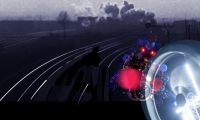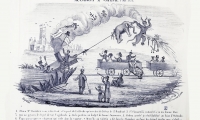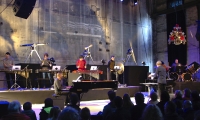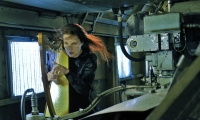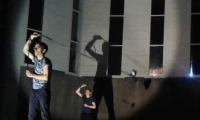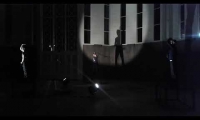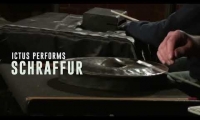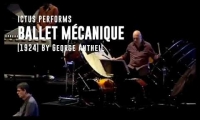
Eric Nerinckx's video report
PROGRAMME
Myriam Pruvot:
4 E.M.M.A.s, performance
Ann Eysermans:
Prélude, for diesel locomotive and harp
Fritz Hauser:
Dreaming Trains / Schraffur, for many performers
George Antheil:
Ballet Mécanique for two pianos, percussions, propellers, rings and siren
with
Tom De Cock, Miquel Bernat, Anita Cappuccinelli, Gerrit Nulens, Eva Reiter, Jean-Luc Plouvier, Jean-Luc Fafchamps
Mario Garuti:
Bezel, for two Paetzold flutes
Gordon Monahan:
Speaker Swinging, for eight performers, LED lights and moving loudspeakers
PRODUCTION
Europalia 2022
In samenwerking met:
Ictus Ensemble,
Kunstencentrum nona,
NMBS,
Centrale Werkplaats Mechelen,
ChampdAction
La Flèche and L'Elephant are the names of the two locomotives that were used to pull the coaches of the very first passenger train on the European continent. That pioneering journey took place in Belgium, on 5 May 1835, between Brussels and Mechelen. La Flèche et l'Eléphant is a one-time event paying homage to that very first ride and was developed on the occasion of EUROPALIA TRAINS &TRACKS by EUROPALIA arts festival and Ictus Ensemble. In Brussels, the audience will step aboard a special train to the impressive SNCB Central Workshop in Mechelen. Especially for this event, the SNCB will open the doors of this huge industrial site, where trains and their components are converted and repaired for the Belgian railway network. Visitors are invited on an artistic journey with numerous special musical and (audio-)visual performances by contemporary artists who will interpret the sounds and images of the train in a unique way.
MARCH 19, 2022
18:00
Train ride Schaerbeek-Mechelen
The public is invited to board a private train at the Schaerbeek station.
During the train ride, you will be accompanied by a sound performance by MYRIAM PRUVOT. By using the various announcement voices of the SNCB, Pruvot has created a new narrative to lead you into a sonic voyage to Mechelen.
18:30
Upon the arrival of the train in Mechelen, the public is guided towards the Central Workshop during a short walk.
19:10 — 21:15
On the site, you will be guided to ANN EYSERMANS’s unique site specific performance: a Prélude for 2 diesel locomotives and harp. This line-up may at first seem incompatible and strange to you. But opposites attract. Two train drivers conjure up the impressive and nostalgic sounds of the HLD 5404 and HLD 6041. The sounds of locomotives idling, and those of compressors and air escaping as well as the roaring transition to a higher speed are all part of their sonic potential. The harp interacts with fragile micro sounds, solid chords and circular movements to create a remarkable counterpoint and melodious interweaving of sound.
You will walk up to the immersive performance by the Swiss composer FRITZ HAUSER, with Ictus musicians, students and volunteers. Dreaming Trains / Schraffur is based on the “scratching” of various objects and tools found in the workshops of Mechelen. A mix of percussion and scratched sounds will be created by a large group of participants, resulting in a special soundscape inspired by the sound-universe of trains.
We then propose our interpretation of the Ballet Mécanique by the American composer GEORGE ANTHEIL. In 1924, this self-proclaimed ‘bad boy of music’, in a gesture of sudden inspiration, radically brought to life the futuristic dream of a ‘machine symphony’: a cohort of acoustic and mechanical pianos (here replaced by synthesizers), four bass drums, three xylophones, thundering propellers, shrieking sirens, and finally a huge cluster of electric bells, combine their inhuman forces in an unimaginable metallic and motorised machinery of sound. We have chosen the original and utopian score published at the time of the premiere – the most ostensibly savage, snarling with mongrel arrogance, seeming to defy Stravinsky on his own turf, in the primitivism of his Noces. In those interwar years, was this an ode to the machine or a cry of terror at the accumulation of overwhelming violence, threatening Europe and the world? Perhaps a bit of both, and does it matter anyway… The piano chords shattering like broken glass, the dissonance sought for its own sake, the relentless repetition, the very particular alchemy of heavy machines and lightning speed make this Ballet Mécanique a totally unique work in the history of the 20th century; it transcends the neo-classical gesture and propels it into unsuspected territories.
From the ashes of Ballet Mécanique rises Bezel, a work by MARIO GARUTI for two double bass recorders: futuristic-looking instruments, as if designed to reveal the performers’ breathing and moving bodies.
The evening ends with Speaker Swinging, a sound and kinetic performance created in 1982 by GORDON MONAHAN. It is an experiment for eight rotary loudspeakers, audio oscillators and LED lamps, set in motion at the end of cables by a group of performer-athletes who seem to have stepped out of a socialist realist painting. Monahan was inspired by the famous rotating Leslie speakers, but also by the “Doppler” effects emitted by all the whirring machines of modernity. Phasing, vibrato, tremolo and acoustic distortions of space are fundamental elements of the work – as are the dramatised gestures of the artists, their effort and their sweat.
21:15 — 22:00
Transit between the Central Workshop and the Mechelen Station.
The audience will be guided back to Mechelen Station where the train to the Schaerbeek Station leaves at 22:00.
La Flèche en L’Elephant zijn de klinkende namen van twee locomotieven die de allereerste passagierstreinrit op het Europese continent vooruit trokken. Die trendsettende rit vond plaats in België, op 5 mei 1835, en reed tussen Brussel en Mechelen.
La Flèche et l’Eléphant is een eenmalig event, dat hulde brengt aan die allereerste rit en dat ontwikkeld werd door kunstenfestival EUROPALIA en het Ictus Ensemble. Het publiek wordt uitgenodigd om in Brussel aan boord te stappen van een speciale trein met als bestemming de indrukwekkende Centrale Werkplaats van de NMBS in Mechelen.
Speciaal voor dit event opent de NMBS de deuren van deze reusachtige industriële site, waar treinen en hun onderdelen worden verbouwd en hersteld voor het Belgische spoorwegnet. De bezoekers worden uitgenodigd voor een artistieke reis met tal van bijzondere muzikale en (audio-)visuele voorstellingen door hedendaagse kunstenaars die de klank — en beeldenwereld van de trein op een unieke manier interpreteren.
19 MAART 2022
18:00
Treinrit Schaarbeek-Mechelen
Het publiek wordt uitgenodigd om aan boord te gaan van een privétrein in het station van Schaarbeek.
Myriam Pruvot
4 E.M.M.A.s
De performance van deze Franse vocaliste en klankkunstenares begeleidt de treinrit van Brussel naar Mechelen. Pruvot gebruikt de omroepstemmen van de NMBS die we kennen van trein en station om een nieuw verhaal te creëeren dat de rit naar Mechelen omtovert tot een bijzonder luisterspel.
18:30
Bij aankomst van de trein in het station van Mechelen wordt het publiek tijdens een korte wandeling naar de Centrale Werkplaats gegidst.
19:10 — 21:15
Ann Eysermans
Prelude voor 2 diesellocomotieven en harp
Componist, harpiste en ’trainlover’ Ann Eysermans brengt een line-up samen die vreemd kan lijken, maar tegengestelden trekken elkaar aan. Twee machinisten toveren indrukwekkende en nostalgische geluiden uit de HLD 5404 en HLD 6041 locomotieven. Het geluid van vertrekkensklare ijzeren mastodonten, sissende compressoren, bulderende motoren verbergt een uitzonderlijk muzikaal potentieel. De harp zoekt haar plaats in dit geweld met fragiele klanken, solide akkoorden en circulaire patronen om zo een opmerkelijk contrapunt te bereiken in een melodieuze verweving van geluiden.
Ictus Ensemble brengt:
Fritz Hauser: Dreaming Trains / Schraffur (Ictus, studenten en vrijwilligers)
Georg Antheil: Ballet Mécanique
Mario Garuti: Bezel
Gordon Monahan: Speaker Swinging
De Zwitserse componist Fritz Hauser brengt een grote groep vrijwilligers van alle leeftijden samen met studenten en muzikanten van Ictus voor de nieuwste versie van Schraffur. De wonderlijke objecten en bijzondere gereedschappen uit de werkplaats worden massaal tot leven geroepen door ze te krassen, schuren en te wrijven tot er een klankwolk ontstaat, een onvergetelijke soundscape geïnspireerd op het universum van de treinen.
Ictus stelt een eigenzinnige lezing voor van Ballet Mécanique van de Amerikaanse componist George Antheil. In 1924 realiseerde de zelfbenoemde Bad Boy van de muziek de futuristische droom van een "symfonie van machines". Een cohort van akoestische en mechanische piano's (hier vervangen door synthesizers), basdrums, xylofoons, donderende propellers, huilende sirenes, en tenslotte een enorme cluster van elektrische bellen creëren een onwaarschijnlijk klankbad van metaal en motoren. Wij kozen voor de oorspronkelijke, utopische partituur die bij de creatie werd gepubliceerd — de meest wilde en ambitieuze die Stravinsky uitdaagt op eigen terrein (-die van het primitivisme van Noces). Was het interbellum een verheerlijking van de Machine, of een angstschreeuw voor het onafwendbare? Een beetje van beide, allicht, en eigenlijk doet het er niet toe. De pianoakkoorden klinken als gebroken glas, de dissonantie heeft genoeg aan zichzelf, de onvermoeibare herhaling, de bijzondere alchemie van machinale zwaarte en snelheid, maken van dit Ballet Mécanique een volstrekt uniek werk in de geschiedenis van de twintigste eeuw; het overstijgt de neo-klassieke esthetiek en katapulteert het naar een onvermoed terrein.
Uit de as van Ballet Mécanique verreist Bezel, een stuk van Mario Garuti voor twee Paetzold double bass recorders een futuristisch ogend instrument dat de ademhaling en beweging van de muzikanten blootlegt en lucht (of is het stoom?) laat ontsnappen tot virtuoze muziek.
Speaker Swinging sluit de avond af. Deze kinetische performance van Gordon Monahan werd voor het eerst opgevoerd in 1982. Het is een experiment voor acht ronddraaiende luidsprekers, audio-oscillatoren en lampen, die atletisch in gang gezet wordt door de performers. Monahan inspireerde zich op de fameuze draaiende Lesliespeakers, maar ook op rijdende voertuigen met omroepsystemen, vliegtuigen en andere snel bewegende geluidsbronnen uit de industrie of de natuur. Het akoestische doppler effect, het faseren, vibrato en tremolo zijn fundamenteel voor het werk. Net als het zwoegen en zweten van de performers.
21:15 — 22:00
Verplaatsing van de Centrale Werkplaats naar het station van Mechelen
Het publiek wordt teruggeleid naar het station van Mechelen waar de trein naar Schaarbeek vertrekt om 22:00.
La Flèche et l’Éléphant : ces deux noms ronflants désignaient deux des locomotives qui tractaient les voitures du premier train de passagers sur le continent européen. Ce trajet pionnier se tint en Belgique le 5 mai 1835, entre Bruxelles et Malines.
La Flèche et l’Éléphant est un événement unique, codéveloppé par l’Ensemble Ictus et EUROPALIA à l’occasion de TRAINS & TRACKS, qui rend hommage à ce tout premier trajet. Passagères et passagers sont invités à embarquer à bord d’un train spécial partant de Bruxelles à destination du gigantesque et impressionnant Atelier central de Malines.
Pour l’occasion, ce site industriel où sont assemblés et restaurés des trains et pièces détachées pour le réseau ferroviaire belge ouvrira ses portes au public pour la première fois. Les passagers de ce train particulier embarquent pour un voyage artistique de performances sonores et visuelles.
19 MARS 2022
18:00
Trajet en train Schaerbeek-Malines
À la gare de Schaerbeek, le public est invité à monter dans un train privé.
Myriam Pruvot
4 E.M.M.A.s
Qui sont ces voix qui nous guident lors de nos voyages en train ? Réelles, irréelles, sur-réelles ? Ont-elles un corps, des caprices ? Myriam Pruvot en fait tout un poème.
Myriam Pruvot vit à Bruxelles ; elle est une grande figure de l’art sonore et de la poésie sonore.
18:30
Promenade guidée d'une vingtaine de minutes, de la gare de Malines vers l'Atelier central.
119:10 — 21:15
Ann Eysermans
Prélude pour 2 locomotives diesel et harpe.
Le train n’est pas que puissance et vitesse : il renvoie l’image d’une modernité presque désuète, et traîne avec lui la nostalgie des départs. Munie de sa seule harpe, Ann Eisermans tente une psychanalyse des trains. La compositrice engage avec les machines une conversation qui peut sembler étrange, mais qui rend grâce à l'attraction des contraires. Deux conducteurs de train font sonner les stridences, toutes chargées de nostalgie, des locomotives HLD 5404 et HLD 6041. Le son du départ des mastodontes de fer, des compresseurs, des moteurs rugissants, cache un potentiel musical exceptionnel. La harpe cherche sa place dans cette tempête en proposant des sons fragiles, des harmonies subtiles et des patterns en boucle.
Ictus joue
Fritz Hauser : Dreaming Trains / Schraffur
Georg Antheil : Ballet Mécanique
Mario Garuti : Brezel
Gordon Monahan : Swinging Speaker
L’art de Fritz Hauser est à la percussion ce que le judo est à la boxe : il ne s’agit plus de frapper, mais de libérer des énergies. Le compositeur a réuni un large groupe de volontaires de tous âges, avec des étudiants et nos musiciens, pour réaliser une version de son légendaire Schraffur, adaptée à cet atelier ferroviaire. Les objets et outils spéciaux de l'atelier reprennent vie tandis que les percussionnistes les grattent, les poncent et les frottent — jusqu'à ce que surgisse un nuage sonore, un paysage sonore calme mais chargé de mémoire.
Nous proposons ensuite notre lecture du Ballet Mécanique du compositeur américain George Antheil. En 1924, l'autoproclamé Bad Boy de la musique réalisait avec fracas, en un geste soudainement inspiré, le rêve futuriste d'une "symphonie des machines" : une cohorte de pianos acoustiques ou mécanisés (ici remplacés par des synthétiseurs), de grosses caisses, de xylophones, d'hélices tonitruantes, de sirènes hurlantes, et enfin un énorme cluster de sonnettes électriques, combinent leurs forces in-humaines en une invraisemblable machinerie sonore, métallique et motorique. Nous avons choisi la partition originale et utopique éditée à la création — la plus ostensiblement sauvage, arrogante, provocante, qui semble défier Stravinsky sur son propre terrain, celui du primitivisme des Noces. En cet entre-deux-guerres, s'agissait-il de glorifier la machine, ou de pousser un cri de terreur face à la violence qui s'amoncelait, menaçant l'Europe et le monde ? Un peu des deux, sans doute, et peu importe : les accords de piano éclatants comme du verre brisé, la dissonance recherchée pour elle-même, la répétition inlassable, l'alchimie très particulière de lourdeur machinique et de vitesse fulgurante font de ce Ballet Mécanique une oeuvre totalement singulière dans l'histoire du XXe siècle ; elle transcende le geste néo-classique et le projette vers des territoires insoupçonnés.
Des cendres de Ballet Mécanique surgit Bezel, une pièce de Mario Maruti pour deux flûtes à bec contrebasse Paetzold — un instrument d'allure futuriste qui semble se nourrir de la respiration de ses interprètes.
La soirée se clôturera avec Speaker Swinging, une performance sonore et cinétique créée en 1982 par Gordon Monahan. Il s’agit d’n classique du sound art : la musique se projette dans l’espace comme des jets de lumière. Huit haut-parleurs rotatifs, oscillateurs audio et lampes LED sont mis en mouvement au bout de câbles par une bande d'interprètes-athlètes semblant tout droit sortis d'une peinture réaliste-socialiste. Monahan s'est inspiré des célèbres cabines rotatives Leslie, mais aussi des effets "Doppler" émis par toutes les machines vrombissantes de la modernité. Phasing, vibrato, tremolo et déformations acoustiques de l'espace sont les éléments fondamentaux de l'œuvre — tout comme l’effort dramatisé des musiciens-machinistes.
21:15 — 22:00
Retour de l'Atelier Central à la gare de Malines
Le public est reconduit à la gare de Malines, d’où le train pour Schaerbeek partira à 22:00.
Agenda for this project
- Date Show Location
-
Sat 19.03 La Flèche et l’Éléphant [Europalia, artistic voyage] Central Workshop - Mechelen - Belgium

